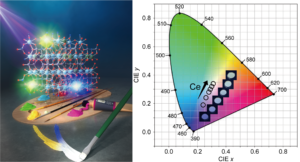
Takuya Yasunaga, Makoto Kobayashi*, Kenji Oqmhula, Huan Qi, Tom Ichibha, Kenta Hongo, Shunsuke Yamamoto, Ryo Maezono, Masaya Mitsuishi, Minoru Osada, Hideki Kato*, and Masato Kakihana, , Inorg. Chem., 2024, 63, 2, 1288–1295.
https://doi.org/10.1021/acs.inorgchem.3c03789
Abstract
White-light emission with a single activator is an attractive function of phosphors. In this work, we investigated the photoluminescence properties of Ca5.7Y1.3Si7O16.7N3.3, which is a compound denoted as Ca4+xY3–xSi7O15+xN5–x discovered by our group, with Ce-activation using optical measurements and density functional theory (DFT) calculation. Samples showed a tunable emission from purple to white under ultraviolet (UV) light. In this compound, Ca and Y as well as anions are distributed disorderly, and Ca/Y ions occupy two crystallographically distinct sites; those sites are possible sites for Ce substitution. DFT calculation and structural refinement revealed that the tunable emission was generated by Ce at the crystallographically equivalent site but with distinct local structures caused by the disordering of cations and anions. As far as we know, this is the first report about a white-light-emitting phosphor with only Ce activation.
